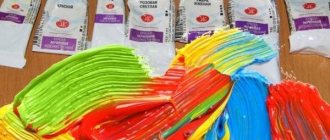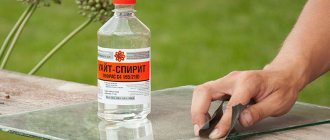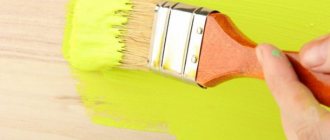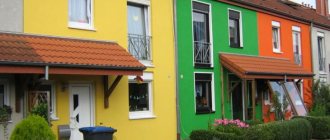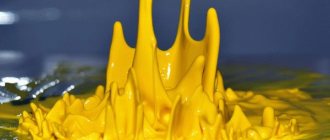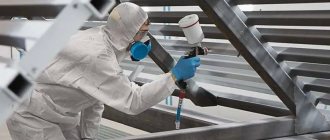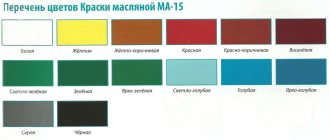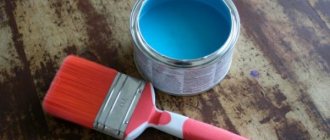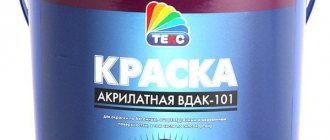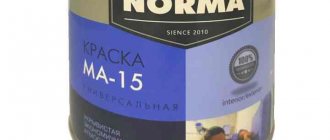MA-25 is an oil paint consisting of fillers and pigments in combined drying oils (K-4, K-3, K-2, K-5), hardeners, and drier. It is used for painting wooden or metal surfaces indoors and outdoors (depending on the composition, some paints have limited weather resistance). The protective coating formed using MA-25 oil paint is characterized by good resistance to moisture, temperature changes, many detergents, atmospheric conditions, and wear resistance.
Paint MA-25 - purpose and scope of application
Production of MA-25 enamel. MA-25 is a universal pentaphthalic paint and varnish material, the binder of which is polycondensation resins. This material is based on alkyd varnish. Thanks to it, the color of MA-25 enamel applied to the surface becomes completely invisible (in the case of the same application to the surface). The enamel is ideal for working with wood and metal surfaces that are constantly exposed to atmospheric environments or used indoors. Finished MA-25 enamel is sold in industrial containers and can be purchased at a competitive price.
Thinners for oil compositions
Oil paint for facade
Unlike ordinary gouache paint, where dilution with water is possible, for oil mixtures it is necessary to use a thinner. They are all different and each of them has its own properties, which we will consider. Looking into art stores, you can get confused in the huge number of existing thinners, and therefore remember that there is:
- Diluent
- Varnish
- Double
- Tee
The thinner is suitable not only for direct thinning of paint, but also for cleaning various surfaces. The tee differs in that, unlike the double, where the composition contains artistic varnish and oil, there is also a thinner. Whether you choose a tee or a regular thinner depends on your intended purpose for using it. If you do not need to save money, then it is better to choose a pure, odorless thinner. Despite its high cost, you will find it more pleasant to work with this material.
Important! When purchasing various materials, pay attention to the odorless solvent. With its help, substrates are degreased, tools are cleaned, and they can also be used to simply dilute oil paints.
MA-25 paint - application method and recommendations for use
Before you start painting the surface, it is necessary to clean the metal surface from corrosion or carbon deposits. After this, you need to degrease with xylene and then treat with an alkyd primer. Wood surfaces must be treated to remove grease and sanded. All existing dirt can be removed using washing powder and soda solution. Next, carefully rinse everything off and dry thoroughly before applying MA-25 enamel.
When applying enamel, you can use brushes, dipping, flowing or spraying. If the enamel is thick, it can be diluted with white spirit, turpentine, solvent, or a mixture of one of them in a 1:1 ratio, while the enamel consumption is approximately 110-180 g/m (depending on the color). MA-25 is perfectly applied to the surface of any material, forming an even tone-on-tone coating over all surfaces.
Features of application
Painting with MA-15 is carried out after preliminary surface preparation. It is cleaned from dirt, grease, stains, dust, remnants of old coating, scale and rust. Potholes and uneven areas must be filled with plaster. To enhance the adhesion strength, it is recommended to apply a primer (alkyd, glyphthalic). New wood should be pre-coated with drying oil or wood primer.
Only dry surfaces can be painted. The paint is mixed before application. If the viscosity is too high, add a solvent - turpentine, a special thinner for oil paints. Application methods: roller, brush, direct pneumatic spray. Air humidity during work is up to 80%, temperature from +5 to +35 degrees. After completion of work, the tools are washed with white spirit.
Consumption per layer
The consumption of 1 m2 of product significantly depends on the absorbency of the surface, the method of application, and the color of the material. Indicator - from 55 to 240 g/sq.m. m of surface. Metal bases require less material than wood bases.
Layer thickness
When measured, the thickness of one layer of MA-15 is 25–30 microns. The coating in two layers is 50–60 microns. It is recommended to apply two layers without primer, or one coat with preliminary priming. The thickness of the layer depends on the preparation of the painters, the method of painting, and the viscosity of the product.
Surface drying
Typically, 24 hours of touch-drying at a temperature of +20 degrees is sufficient. But depending on weather conditions, temperature and humidity in the room, the period of complete drying can be 4–120 hours. The final properties of the material appear after 5 days from the moment of application.
Coating service life
If you meet all the requirements for surface preparation, paint and dry correctly, then a 2-layer coating will last for at least a year. We are talking about the complete preservation of its decorative properties when used in a temperate climate. Application temperature – from –45 to +60 degrees.
Painting schemes
For metal, the surface should first be primed with primers of the GF, VL, PF, FL brands. If there is rust, first apply a layer of Unicor or rust converter. Then apply 2 layers of MA-15 paint. Iron products without traces of rust can be painted in 2 layers without a primer, wooden ones treated with drying oil - in 1-2 layers.
Paint MA-25 - technical characteristics
Any colors, tinting according to RAL. The enamel can withstand temperature fluctuations from 50 to +60°C. The coating is resistant to water, atmosphere and various chemicals. The shelf life is no more than 12 months from the date of issue. The amount of non-volatile substances in% ranges from 49 to 70. Drying time for MA-25 enamel to the third degree at a temperature not exceeding +20°C:
- cherry or red – 48 hours;
- other colors – 24 hours.
Film adhesion is no more than 1 point;
The elasticity of the film ball when bending is no more than 1 millimeter. For the production of MA-25 enamel, exclusively high-quality domestic raw materials are used, which guarantees excellent technical performance of the substance and its low price. You can buy MA-25 enamel right now using our website. The price on the website is current.
What do the standards regulate?
Brands of oil compositions depend on the type of drying oil used.
Manufacturers produce thickly grated oil compositions, which must be diluted with drying oil before use, and liquid ones that are ready for use.
Some provisions of the documents
GOST 8292 85 for oil-based colored thick-based paints defines the following brands:
- MA-021 - on natural drying oil;
- MA-015 and MA-025 – on a combined or natural film-forming substance;
- GF-023 – on glyphthalic drying oil;
- PF-024 - on a pentaphthalic analogue.
The main characteristics of thickly grated oil-based paints and varnishes must comply with this GOST.
Thickened paints should be diluted before use.
- Grades MA-015 and 025 – 20/30% drying oil of the total volume of material. The composition of MA-15 based on red lead, mummy and ocher pigments is diluted with 30/40% film former.
- MA-015 paints in all types of colors are diluted with natural drying oils or combined analogs of K/3 and K/5.
- Compositions MA-025 are diluted with natural drying oil, “Oxol” or combined oils K/2, K/3 and K/5.
- Analogues of the GF and PF brands are diluted to the desired consistency with appropriate film formers.
- Oil paint according to State Standard 8292 85, after diluting it with drying oil, can be diluted with a solvent as necessary. Its volume should be no more than 5% of the mass of the paintwork material.
Some of the characteristics of the compositions, according to the standard.
Note! To obtain a high-quality liquid coating ready for use, oil paints in accordance with State Standard 10503 71 must be diluted in a certain ratio. It is 50 g of oil per 1 kg of thickly grated paint.
The most important material characteristics
The photo shows paint made according to the interstate standard.
To choose the paint correctly, you need to be guided by its technical characteristics. It should be taken into account that since 2003, State Standard 30884 2003 has been in force in the Russian Federation for ready-to-use oil paints.
This standard is interstate, i.e. it is accepted in all CIS countries.
- The mass fraction of film-forming agent in paintwork materials must be at least 26% . This component determines the ability of the finish to create a monolithic coating when applied to the base. The more film former, the better the paint will adhere to the surface. However, this also complicates its preservation.
If the paint is sealed in a can, it can last for years. After contact with air, it cannot be stored for a long time. The composition will harden quickly.
- The proportion of volatile substances in the paint should not be more than 10 percent . These components evaporate at temperatures above +20 degrees. Such substances have a pungent odor and are harmful to our health.
- The degree of grinding of paint components . The finishing features depend on it. You can create two types of coating with your own hands: smooth (the grinding of components is less than 90 microns) and a fine-grained analogue (all paint particles have a diameter of less than 90 microns).
The viscosity of the paint can be checked with a capillary viscometer.
- The viscosity of the dye affects its fluidity and drying period . The first indicator should be 65/140 units. The maximum period during which oil paints harden according to State Standards should be one day.
- The most important characteristic is the hardness of the paint coating . This value determines the ability of the film to prevent solid objects and bodies from penetrating deep into it. According to State Standards, oil-based thick paints must have this indicator of at least 0.13 units.
- A separate point of characteristics is the hygroscopicity of the coating, i.e. its ability to transmit moisture (in connection with it - the paint’s resistance to water).
For compositions intended for external work, the value should approach zero. A resistance level of 0.5/1 is acceptable for compositions used for interior finishing work.
Results
Always pay special attention to the materials you use for exterior decoration. Possessing the required qualities for exterior painting, oil mixtures remain in great demand for independent and professional use. Also, do not forget about the correct choice of suitable tools that are used to paint surfaces. By fulfilling all the requirements and conditions for holding such events, you will undoubtedly be satisfied with the results of the work done with your own hands.
Choosing available tools
Oil paint for exterior use
In addition to the fact that you should pay due attention to the choice of paint, you should also pay attention to the brushes for work. The fact is that for a high-quality coating you need not only a good composition, but also good paint brushes play an important role. Let's look at what tools you need to use.
Paint brushes vary in size, shape and type of bristles. To make it convenient for you to paint surfaces, pay attention to the following properties of brushes:
- Choose brushes that are convenient for you. They should fit well in the hand and with proper care, their use will be long and productive
- Check how tightly the bristles are attached to the tool. If some hairs fall out during painting, then a damaged coating cannot be avoided.
- Split hairs on the tips of the brushes allow you to apply paint as best as possible
- The hairs at the edges of the brushes are slightly shorter than in the middle. Thanks to this, you have the right to control the area of painting yourself.
The shape of the brushes also plays an important role. The flute is a universal form and is used for different surfaces. It has a flat shape and a long handle. Radiator brushes are suitable for radiators thanks to an even longer handle that is curved near the bristles. For places that are called hard to reach, it is better to take a round brush. Although it is inconvenient, it is suitable for oval products. Use the oval to paint corners and flat surfaces.
Tools with both natural and artificial bristles are suitable for pairing with oil-based paints. Synthetic tools are more durable and therefore slightly more expensive than pig bristle brushes.
We clean the surface from old coatings
Painting the walls of the house with oil paint yourself
When it's time to remove the old covering from the walls, you should understand what you can use to do this. Chemical remover is actively used by both professional and amateur craftsmen. But before you remove them from the walls using oil paints, do not forget about personal protection from the components of the remover.
Ventilate the room where the oil coating will be dismantled. After applying the remover, wait until the paint begins to bubble, and then use a spatula to remove any loose pieces. You can mechanically remove paint from walls using a sander and grinder. It is worth switching to this method if chemical removers do not give the desired effect. A hair dryer will also help to remove paint efficiently. But here you need to stock up on the help of a friend. When one of you directs a hair dryer to the surface of the walls, the other will use a spatula to remove the oil mixture softened with hot air. However, do not forget that it is not recommended to overheat the paint until it chars. To completely remove the oil mixture, you need to make some effort and devote a sufficient amount of time to this.
